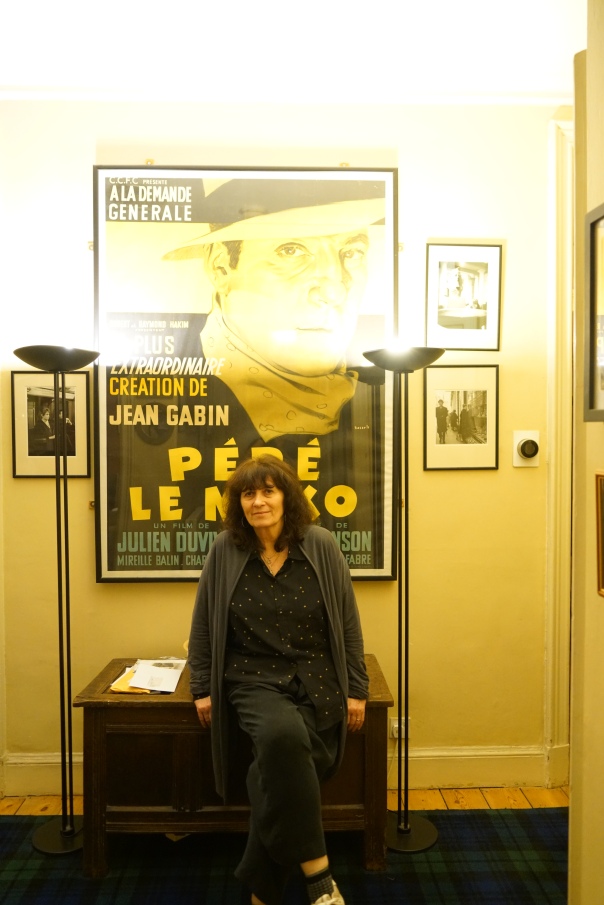
Scott (Robert Ryan) is a coastguard who’s boat was torpedoed during the war and is suffering from Post Traumatic Stress Syndrome. He’s got a beautiful girlfriend, Eve (Nan Leslie), and they’re planning to marry. But he´s not quite well and they decide to wait. Big mistake. One day he meets a woman on the beach, Peggy (Joan Bennett). She’s no good. She’s married to a blind painter, Tod (Charles Bickford) and has already cheated on him once before. For Scott, meeting Peggy is like coming out of a fog and into a compulsion, and is beautifully visualised for us by Renoir (see below).

For Peggy meeting Scott is… well who knows for sure. The film leaves it deliciously ambiguous. Sometimes the film indicates that he’s just some bit of juicy meat to her. Other times, a means out of an increasingly self destructive and interdependent relationship with her husband. As you can see below, she admits to cheating on her husband before: ‘I’m a tramp, say it. ‘And whilst she admits to being a tramp she certainly makes no apologies for it. Watching Bennett, perhaps the surliest female presence in all of American cinema, is a pleasure all film noir lovers will recognise.
In Jean Renoir: A Biography, Pascal Mérigeau writes that, ´Renoir knew that he wouldn´t be able, as he´d confirm after the project, to attempt something that I´d wanted to do for a long time: a film about what you´d call sex today..but envisioned from the point of view of the purely physical,¨and that it would be impossible ¨to tell a story about love in which the reasons for attraction between the different parties were purely physical, a story in which sentiment would play no part at all¨ (location 11636, Kindle edition).
The film has a discourse on art by someone who should know: Renoir fils learned a thing or two about it from his father and his friends: the painter who can no longer see, who’s vision is entirely encapsulated in paintings increasingly gaining in value because he can no longer make them, who’s tied to the past in those works and thus also imprisons she whom he loves most, a woman who might only be staying with him for what those paintings are worth…it’s almost too much as a plot though Bickford is wonderful as the blind but still controlling husband, his gaze almost always in the right place so it rouses suspicions as to whether he really is blind.
The nightmare sequences at the beginning and end are wonderfully modernist. The first one, which starts the film is below:
…and useful to compare to the one near the end:
Renoir is extraordinary in creating a mood, a sense of physical compulsion in which questions of morality are over-ridden by desires that can’t be fully comprehended. Mérigeau writes, ‘there´s nothing to please a viewer who may have been attracted to the idea of seeing a film noir. Although it truly is a film noir, it contains no crime other than those that might exist in the minds of the characters, who need to get rid of their traumas, obsessions, and fantasies if they are ever to escape their deep, adherent isolation’ (location 11738)
The ending makes no sense to me. It is perhaps arrived at too quickly and I plan on looking into the production history of the film at a later point (and due to the wonders of social media Adrian Martin has kindly pointed out to me that Janet Bergstrom has written a dossier on the troubled production, Janet Bergstrom, ‘Oneiric Cinema: The Woman on the Beach,¨Film History 11 (1) (1999) 114-125) ..But I loved it in spite of that and plan to see it again.
The Woman on the Beach was Renoir’s last American film, one in which he says, ‘I wanted to proceed more by suggestion than by demonstration: a film of acts never carried out..This gives the film an ambiguity that well-complements its intensity: strong feelings not quite understood but carried on into actions, many of them later regretted.
It´s a film Renoir tried to forget, without ever quite disowning. It´s certainly imperfect. But it´s also a very beautiful film, a hypnotic presentation of a lulling into sexual desire and physical compulsion that deserves to be seen again and again in spite of its faults
José Arroyo
Bibliography:
R. B.Jones, The Lives of Robert Ryan
Pascal Mérigeau: Jean Renoir: A Biography, RatPac Press, 2016, translated by Bruce Benderson with a Foreword by Martin Scorsese.
















